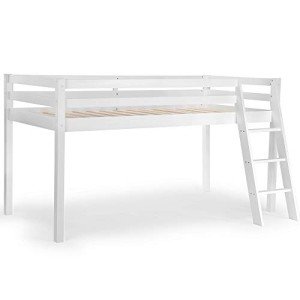Wisdom On Cabin Bed Ladder From A Five-Year-Old
Cabin Bed Ladder The cabin bed ladder is made from solid Southern Yellow Pine. Like telephone poles material is extremely strong and robust. The bed ladder has two ends. One is clipped onto the frame, and the other end, with the rungs that you hold. You can position the ladder on either the foot or side of your mattress. Safety Features A bed ladder in a cabin must be strong and durable to ensure safety. It should be firmly attached to the bed without gaps, or looseness which could cause children to climb from their beds or fall off the ladder. Many manufacturers offer professional installation services to guarantee an uninjured and secure loft or bunk bed. However, it is important to read all instructions and safety warnings thoroughly prior to attempting DIY installation. The ladder should be angled correctly. Ladders with a slight incline help younger children to reach the top bunk, and are safer to climb than traditional vertical ladders. This type of ladder needs slightly more space than a standard ladder for bunk beds, but the extra space is worth it to reduce the chance of accidents. To prevent injuries, the ladder should also have smooth surfaces and rounded edges. Rounded corners eliminate sharp edges that could catch clothing or catch it. Sanding the steps and ladder frames removes any rough materials and remove the risk of splinters. Some models have drawers for storage within the steps to add functionality without risking safety. A loft bed or bunk bed ladder should have guard rails that are at least 5 inches above the mattress's surface to safeguard sleepers from accidental falls in the course of play or sleep. Some models come with removable railings that offer flexibility and adaptability, while others have permanent railings for stability over the long term. A movable Ladder Gate will prevent your children from climbing to the highest level of the ladder during the night if they are sleepwalkers or dreamers. A Ladder Protector can safeguard your kids from injuries when climbing up to the higher level. Before buying a bed that has a ladder, you should measure the dimensions of the bedroom of your child to ensure that it has enough space to accommodate the bed and any other features that could be connected to it. It's also important to consider the ceiling's height, especially in the case of a tall sleeper model. A loft bed or bunk bed that is too close to the ceiling could hinder air flow and create discomfort. It also presents the risk of fire and could obstruct windows, which can cause injury due to broken glass or falling objects.  Length To ensure safety, you want to be sure that the ladder is the correct length for the space you have. You don't need it too high or too low. For children, it's best to keep the rungs around 10 inches apart, and for adults 12 inches apart. The rungs should also be rounded at the ends. cabinbeds can give splinters or be rough to the feel. This is especially important when you're building your own bunk bed ladder. It's easy to overlook. The position of the ladder on the bed frame is important. The most common place is at the bottom of the bed however, you can also fix it to the side of the bed. Both positions have their advantages and drawbacks, so it's left for you to decide which one is best for your bedroom. Design In contrast to traditional ladders, which are attached at the bottom of the bed or on the frame's side, a cabin bed ladder attaches to one end of the frame. The user holds the other end with the rungs. This design allows for more freedom of movement in the bed, which is especially beneficial for those who have had abdominal surgery or have limited mobility. The fact that a bed ladder for cabins is attached only at one end makes it very easy to set up and use. This is especially important in camper bunks, where space is often limited.
Length To ensure safety, you want to be sure that the ladder is the correct length for the space you have. You don't need it too high or too low. For children, it's best to keep the rungs around 10 inches apart, and for adults 12 inches apart. The rungs should also be rounded at the ends. cabinbeds can give splinters or be rough to the feel. This is especially important when you're building your own bunk bed ladder. It's easy to overlook. The position of the ladder on the bed frame is important. The most common place is at the bottom of the bed however, you can also fix it to the side of the bed. Both positions have their advantages and drawbacks, so it's left for you to decide which one is best for your bedroom. Design In contrast to traditional ladders, which are attached at the bottom of the bed or on the frame's side, a cabin bed ladder attaches to one end of the frame. The user holds the other end with the rungs. This design allows for more freedom of movement in the bed, which is especially beneficial for those who have had abdominal surgery or have limited mobility. The fact that a bed ladder for cabins is attached only at one end makes it very easy to set up and use. This is especially important in camper bunks, where space is often limited.